The Green Line of Dubai Metro: An In-Depth Examination
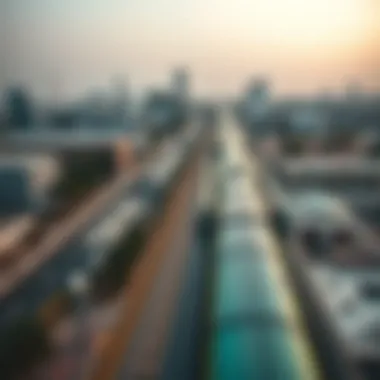
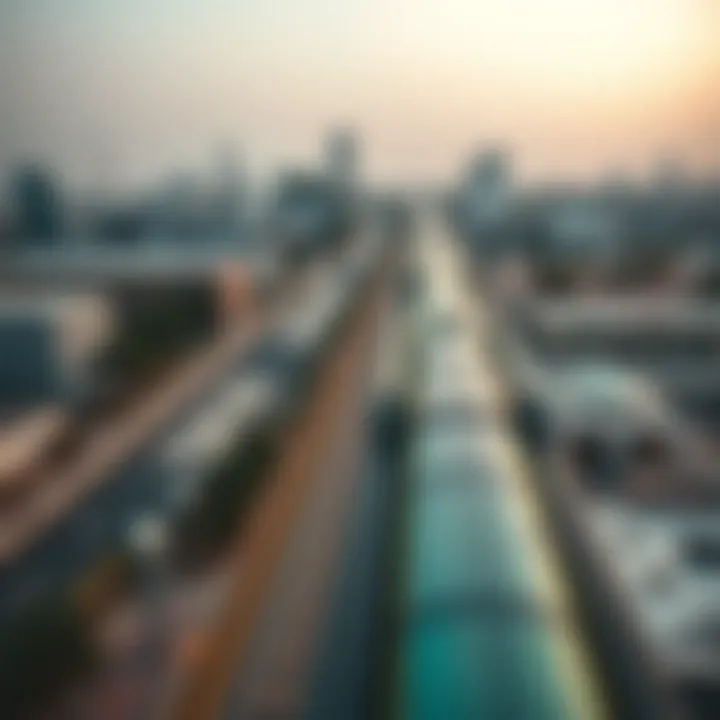
Intro
The rapid development of Dubai has transformed it into a bustling metropolis, and a critical component of this transformation has been the introduction of its metro system. Among the various lines that make up this impressive urban transport network, the Green Line stands out for its unique characteristics and vital role in fostering connectivity across the city. This section will discuss the significance of the Green Line, its operational details, and its influence on the urban landscape, focusing particularly on real estate trends and investment potential in areas linked by this line.
The Green Line stretches from Al Ghusais to Jadaf, passing through some of Dubai's most vibrant neighborhoods. It's not merely a mode of transportation; it embodies the city's commitment to sustainable development and urban planning. Significant areas such as Bur Dubai, Al Seef, and Dubai Healthcare City are all accessible through this line, featuring high foot traffic that translates into substantial investment opportunities.
In analyzing the Green Line, one cannot overlook its architectural elements. The design of the stations and the overall infrastructure reflects a blend of modern aesthetics with cultural nuances that characterize Dubai. The stations are thoughtfully integrated into the urban fabric, providing easy access to retail, dining, and leisure activities, contributing to the livability of the areas they serve.
Moreover, the Green Line's impact on property values cannot be underestimated. Properties located in close proximity to metro stations often see a notable increase in demand, as accessibility becomes a key factor for potential buyers and tenants alike. Investors and homebuyers are increasingly drawn to neighborhoods along the Green Line, making it essential to grasp the ongoing trends and implications for real estate here.
As we navigate through the specifics of the Green Line, we will embark on an examination of market insights, investment strategies, and how this transit development shapes the dynamics of Dubai’s real estate sector. Understanding these elements provides valuable context for both current and aspiring investors in the evolving landscape of Dubai's property market.
Prologue to the Green Line
The Green Line of the Dubai Metro is more than just a transit option; it represents a pivotal shift in how the city integrates sustainable urban mobility into its sprawling landscape. In an age where urban centers face unprecedented challenges in traffic congestion and pollution, the Green Line offers a viable solution that prioritizes efficiency while spearheading eco-friendly initiatives. It connects critical areas, enhancing the accessibility for both residents and tourists, and reshaping the urban identity of Dubai.
Overview of Dubai Metro
The Dubai Metro, inaugurated in 2009, is a state-of-the-art rapid transit system that stands as a symbol of the city’s commitment to modernity and progressive urban planning. With its automated trains and extensive network, it segments the city into efficient transit corridors. The Green Line specifically serves as a crucial artery, linking various neighborhoods and commercial hubs, facilitating smoother travel for its passengers. This metro line stretches approximately 22 kilometers and features 18 stations, each designed to cater to the diverse populace of Dubai.
- Key Highlights:
- Over 600,000 daily riders prior to the pandemic, showcasing its significance in daily commutes.
- A seamless connection to Dubai International Airport, providing accessibility for travelers.
- Integration with various bus routes and other metro lines, enhancing intermodal transport.
Historical Background
The conception of the Green Line is rooted in Dubai's ambitious vision to become a global city. The proposal for the metro was made in the early 2000s as a response to escalating traffic woes, resulting from rapid urbanization and a population surge. Initially, plans were set to unveil the system in 2006, but the opening was pushed to 2009, coinciding with Dubai's recovery from the financial crisis.
- Milestones in the Metro Development:
- In 2008, the Green Line project was officially launched, with construction completed in record time.
- The line was extended in subsequent years to further connect emerging districts such as Al Jaddaf and Dubai Healthcare City, responding to the demands of a growing population.
These historical aspects create a framework for understanding the system’s evolution and how it has become indispensable to the urban fabric of Dubai. The importance of the Green Line cannot be overstated; it symbolizes a forward-thinking approach towards urban mobility and sustainable development in one of the most progressive cities in the world.
Route and Stations of the Green Line
The Green Line of the Dubai Metro serves as a vital artery of the city’s comprehensive transportation network. It connects various key districts, making urban mobility more accessible and efficient. This segment of the metro system not only reduces travel time but also enhances connectivity among important commercial, residential, and healthcare hubs. For investors and potential homebuyers, understanding the route and stations is crucial as it has significant implications for property values and urban development.
Key Stations along the Route
Al Rigga Station
Al Rigga Station stands out as one of the most bustling stations along the Green Line. Notably, it is strategically located in the heart of the Deira district, a lively area known for its mix of business and culture. The station is characterized by its direct access to numerous restaurants, shops, and entertainment venues, making it a favorite among locals and tourists alike.
The distinctiveness of Al Rigga Station lies in its proximity to various amenities. This ensures that commuters can easily switch between work and leisure activities without significant delays, creating a seamless urban experience. Additionally, the station provides a convenient link to nearby bus stops, enhancing its accessibility.
However, its popularity can also lead to overcrowding, especially during peak hours. Despite this challenge, the benefits it offers in terms of accessibility and connectivity significantly enhance the urban landscape of Dubai.
Union Station
Union Station serves as a pivotal interchange between the Green Line and the Red Line. This station is not merely a transit point; it plays a crucial role in facilitating public transport across Dubai. One key characteristic of Union Station is its spacious layout, designed to handle the high volume of daily commuters, effectively minimizing congestion.
The unique feature of Union Station is its architectural design that incorporates both functionality and modern aesthetics. Features such as wide concourses and escalators make transitions between lines smooth for passengers. For those investing in properties nearby, the station's significance cannot be overstated as it enhances the potential for higher property values due to increased foot traffic.
However, while Union Station is a great hub, it does have its nuisances too. With so many travelers passing through, the station can become noisy and chaotic at times, especially during rush hours. Nonetheless, it remains an essential component of Dubai’s transport synergy, making it much sought after by those considering living close to key transit points.
Dubai Healthcare City Station
Dubai Healthcare City Station is pivotal in linking the Green Line to the vibrant healthcare sector of the city. As the station caters predominantly to healthcare professionals and patients, its importance cannot be overlooked. One significant aspect of Dubai Healthcare City Station is its proximity to a multitude of healthcare facilities, including hospitals, clinics, and wellness centers, providing unparalleled convenience.
One of the station's unique features is its thoughtful design, which prioritizes easy access for patients and medical personnel. Its spacious waiting areas and clear signage are beneficial for those who may be feeling unwell or rushed for time. Furthermore, investing in properties close to this station can prove to be lucrative. The demand for residential spaces in areas adjacent to healthcare facilities is increasing, thereby boosting property values considerably.
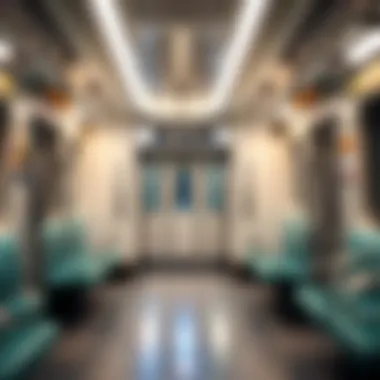
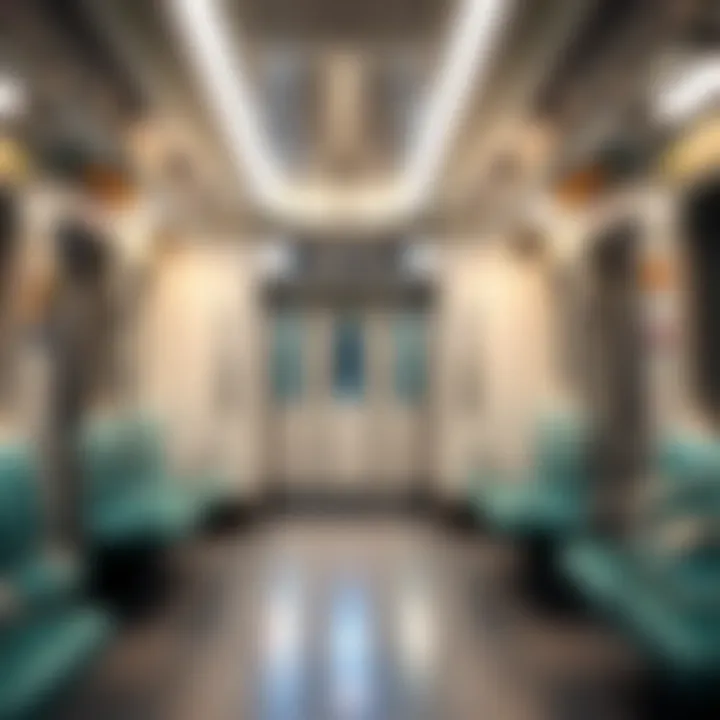
However, while it serves a specific community, the station’s traffic may be less consistent compared to the bustling central stations, which can affect the overall accessibility at certain times.
Connection to Other Lines
The connectivity offered by the Green Line is further enhanced through its integration with other metro lines. Notably, it connects smoothly with the Red Line at Union Station and also links with future extensions planned for the network. This interconnectedness is essential for fostering greater mobility, making the metro an essential choice for commuters and reinforcing the overall efficiency of public transport in Dubai. By facilitating easy transfers, the metro system supports not only daily commuters but also attracts tourists who wish to explore the city more readily.
Operational Aspects
The operational aspects of the Green Line of the Dubai Metro play a critical role in its efficiency and effectiveness, representing the backbone of this modern transportation system. Understanding these elements is essential for prospective investors, homebuyers, and property managers, as they directly relate to the usability and appeal of the Metro as a reliable means of transit in a bustling urban environment.
Schedule and Frequency
The schedule and frequency of the Green Line services are paramount in defining user experience. Trains typically run every 4 to 7 minutes during peak hours and may extend this interval during off-peak times. This regularity ensures that commuters do not face long waits at the stations, making it a desirable option for the daily workforce and residents alike.
Furthermore, the operational hours cater to various lifestyles. The Green Line operates from 5:30 AM until midnight on weekdays and has extended hours during weekends. Such flexibility increases the Metro's appeal among various demographics, from busy professionals to those enjoying leisure activities in the city.
Ultimately, reliable scheduling translates not only into convenience for users but also increased ridership. When people know they can rely on a dependable schedule, they are more likely to choose public transport over personal vehicles.
Technological Integration
Integrating cutting-edge technology into the operations of the Green Line has far-reaching implications. The metro uses state-of-the-art systems for everything from ticketing to train control.
One notable feature is the smart card system employed in Dubai's transport network, particularly the NOL card. This allows seamless access across various transport modes, enhancing user experience by simplifying payment methods—eliminating the need for cash or multiple tickets.
Moreover, the use of real-time tracking systems enables passengers to monitor train schedules and updates live. Displays at stations and on apps inform commuters of arrival times, delays, and other crucial updates, fostering a sense of control over their journeys.
Additionally, the incorporation of sensors and AI into train operations helps optimize maintenance schedules, ensuring that rolling stock is serviced and operational when needed. This proactive approach minimizes service disruptions and contributes to overall safety.
"Integrating technology with transportation significantly enhances efficiency and user satisfaction, ultimately creating a more attractive urban mobility landscape."
All these operational aspects underscore the Green Line's significance beyond mere transportation. They highlight an investment in user experience, sustainability, and smart city initiatives. In a rapidly evolving urban environment, staying ahead in operational efficiency will be crucial in meeting the growing demands of the city's diverse population.
Architectural Features
When considering the Green Line of Dubai Metro, one cannot overlook the architectural features that contribute to its functionality and aesthetic appeal. These elements reflect not just the technological ambition of Dubai but also its cultural identity and aspirations for sustainable urban living.
Design Philosophy
The design philosophy behind the Green Line is rooted in practicality as well as modern aesthetics. Each station embodies a blend of futuristic designs and local architectural themes, allowing them to meld seamlessly with the surrounding urban fabric. For instance, a prominent aspect of the stations is their spacious entrances, which have large, glass panels that allow natural light to flood the interiors. This not only enhances the passenger experience but also reduces the need for artificial lighting, making these spaces feel open and welcoming.
Moreover, the design integrates functionality with elegance. Stations are equipped with elevators and escalators for accessibility, complying with modern standards for inclusivity. The use of eco-friendly materials and technologies, such as energy-efficient lighting and climate control systems, highlights a commitment to sustainability that aligns with Dubai's broader environmental goals.
Sustainability Initiatives
Sustainability is at the heart of the architectural decisions made for the Green Line. Various initiatives have been undertaken to ensure that the construction and operation of the Metro system have a minimal environmental footprint.
- Green Roofs: Some station designs incorporate green roofs that not only aid in thermal insulation but also contribute to biodiversity within the urban environment. These rooftop gardens hold rainwater and provide habitats for local fauna.
- Rainwater Harvesting: Systems have been installed to capture rainwater, which can be repurposed for irrigation of surrounding landscapes. This reduces reliance on treated water and promotes a sustainable approach to resource management.
- Solar Panels: Future expansions are expected to include solar panels on station rooftops, harnessing solar energy to power station operations, thus minimizing energy consumption from non-renewable sources.
- LEED Certification: Many of the stations seek Leadership in Energy and Environmental Design (LEED) certification, a globally recognized symbol of sustainability achievement. This serves as a benchmark for the environmentally responsible design and construction of the metro stations.
"Sustainable practices are not just a trend, they are a necessity for urban development, especially in rapidly growing cities like Dubai."
The architectural features of the Green Line—characterized by innovative design and a commitment to sustainability—reflect Dubai's ambition to establish a modern yet environmentally conscious landscape. As the city continues to evolve, these features will likely play a critical role in setting benchmarks for future development in urban transport systems.
Impact on Urban Mobility
The Green Line serves as a crucial artery within Dubai's expansive public transport system, weaving through the urban landscape and connecting major city hubs. In a city known for its rapid development, the impact of the Green Line on urban mobility cannot be overstated. Traffic congestion, a pervasive issue in metropolitan areas, is significantly mitigated by the efficient operation of the metro. This section delves into how the Green Line contributes to easing roadway strain and enhances public transport options, making the city's transit network not just extensive, but also highly effective.
Reduction of Traffic Congestion
One of the most noticeable benefits of the Green Line is its direct influence on reducing traffic congestion in Dubai. As one hops on a train at Al Rigga Station, they’re part of a shift from cars to public transport. This not only lightens the load on the roads but also helps in cutting down the time spent in everyday commutes. The reduction of vehicles on the streets leads to smoother traffic flows, which is a blessing for everyone on the road.
- Key Points to Consider:
- Decreased Road Usage: A busy commuter who opts for the subway reduces their need for a car journey, thus contributing to lesser cars on the roadway.
- Fast Travel Times: Direct routes offered by the metro allow commuters to reach their destinations faster than most ground transport options.
- Crisp Reliability: With trains running at regular intervals, commuters experience less waiting time, further unclogging the streets.
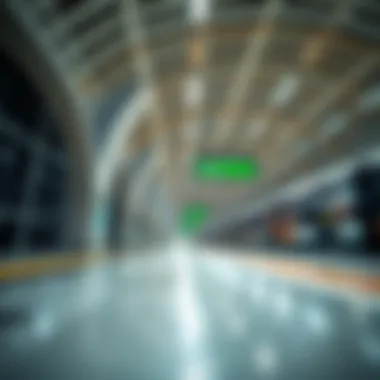
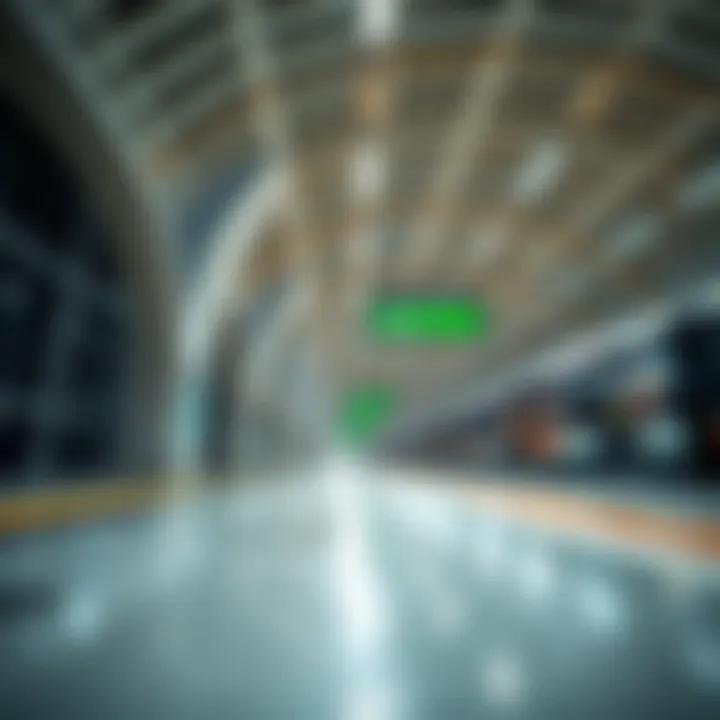
A study conducted by the Dubai Roads and Transport Authority pointed out that in the years following the Green Line's launch, traffic congestion levels dropped notably. In simple terms, fewer cars mean less honking and more peaceful journeys.
Enhancing Public Transportation Options
The Green Line doesn’t just help in reducing congestion; it intricately enhances the overall public transportation framework in Dubai. An extensive and well-connected transit system is vital for a city to thrive, catering to diverse needs—from the daily worker to tourists exploring the urban pulse.
Public transportation options in Dubai have evolved, thanks to the metro's integration.
- Various Forms of Transport: Commuters can interchange seamlessly between the Green Line and the Red Line, optimizing their travel plans.
- Accessibility to Essential Areas: Stations such as Dubai Healthcare City and Union Station provide essential linkages to key sectors like healthcare and business, promoting economic mobility.
- Facilitates Eco-Friendliness: By encouraging the use of public transit, the metro line supports sustainable practices in urban transportation, reducing carbon footprints for a healthier environment.
The convenience of hopping on a train that takes one close to their destination means less reliance on personal vehicles. Not only does this make everyday travel less of a chore, but it also fosters a culture of public transport utilization. In a nutshell, the Green Line is a marvelous example of how metro systems can significantly reshape urban mobility, moving everyone toward a more connected and congestion-free future.
"The true value of effective public transport lies not in the miles it covers, but in the lives it transforms."
For further insights on the evolution of public transport in Dubai, visit Dubai's official RTA site.
Influence on Real Estate
When we talk about the Green Line of the Dubai Metro, it’s essential to explore how it interacts with the real estate landscape. The line isn't just a mode of transport; it’s a lifeblood for neighborhoods, property developers, and investors alike. Essentially, the Green Line acts as a conduit, stimulating growth and altering the dynamics of property values in the areas it services.
One of the primary benefits seen from this metro line is the increase in accessibility. Areas that were once deemed less desirable due to limited transport options have now become hot properties. It’s a simple yet profound correlation: the easier it is to get to a location, the higher the demand for housing there.
Moreover, many investors have begun to realize that proximity to a metro station can be a game changer when assessing the potential value of a property. The trend is palpable in neighborhoods such as Dubai Healthcare City and Al Rigga, where developments have sprung up like daisies after rain, thanks to the added benefit of being on the Green Line.
"Access equals desirability, and desirability directly impacts property values. This isn’t just real estate 101; it’s a crucial factor in investment strategies today."
Property Values Near Green Line Stations
Studying property values near Green Line stations provides fascinating insights. The real estate market has illustrated a consistent pattern where properties situated within a 500-meter radius of metro stations generally see an uptick in their market values. This rise isn’t merely speculative; it’s rooted in convenience. For potential buyers, living near a metro station means less time spent in traffic and more time enjoying life’s finer details.
- Key points regarding property values include:
- Increased Demand: As the metro becomes a staple of daily commutes, demand for properties nearby naturally escalates.
- Higher Rental Yields: Properties close to stations tend to generate higher rental yields, thus attracting more investors.
- Gentrification: Areas around stations often become gentrified, raising standards and property values alike.
Analyzing recent sales data reveals that properties in neighborhoods such as Union Station have experienced value increases of up to 20%. This trend is particularly pronounced in newly developed residential complexes that offer modern amenities and are strategically located.
Investment Trends Following Line Extensions
The potential of the Dubai Metro Green Line doesn't stop at its existing routes. Planned extensions are on the horizon, and they too will leave a mark on investment trends. Investors are increasingly looking for opportunities ahead of these developments. As the line expands, the forward-thinking strategy is to act fast, investing in areas that will soon become accessible.
Consider the pattern of previous extensions; property values often surge before and after announcements of new stations. This begs the question: what future developments are on the docket? Investors need to keep their eyes glued to plans released by the Roads and Transport Authority. Forecasting trends have shown that pre-emptive investments can yield substantial returns through appreciation in value.
- Important factors influencing these trends are:
- Increased Connectivity: Properties previously out of reach become easily accessible, making them more attractive.
- Commercial Development: Business opportunities typically follow transportation developments, attracting more home buyers and renters to the area.
- Investor Sentiment: The excitement generated by potential growth and development pulls in investors, which only adds fuel to the fire of rising property values.
Lifestyle Considerations
The Green Line of the Dubai Metro is not just a means of transport but also a catalyst for lifestyle enhancements within the urban fabric of the city. Understanding the lifestyle aspects connected to the Green Line reveals its broader implications for residents and investors alike. As families, young professionals, and businesses capitalize on proximity to the metro, the benefits extend beyond mere convenience.
Residential Developments along the Green Line
Residential spaces around the Green Line reflect a growing trend towards urban convenience and integrated living. Developers are keen on creating communities that leverage the accessibility niche provided by the metro. For instance, neighborhoods like Al Rigga and Healthcare City are transforming into bustling hubs filled with apartment complexes and gated communities, appealing to a diverse range of residents, from expatriates to locals.
Benefits of Residential Living Near the Green Line:
- Accessibility: Residents can easily commute to and from work, reducing the overall travel time dramatically.
- Community Vibe: The integration of residential developments with transportation hubs cultivates a sense of community, as more people frequent local amenities.
- Potential for Appreciation: Properties near metro stations often show increased property values, attracting investors looking for promising returns.
In essence, homes close to the Green Line not only fulfill a housing need but also offer a dynamic living experience enriched by entertainment, dining, and recreational options aligned with metro access.
Commercial Opportunities
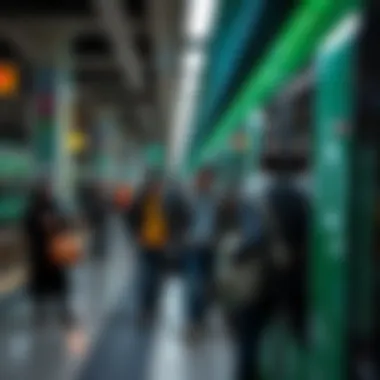
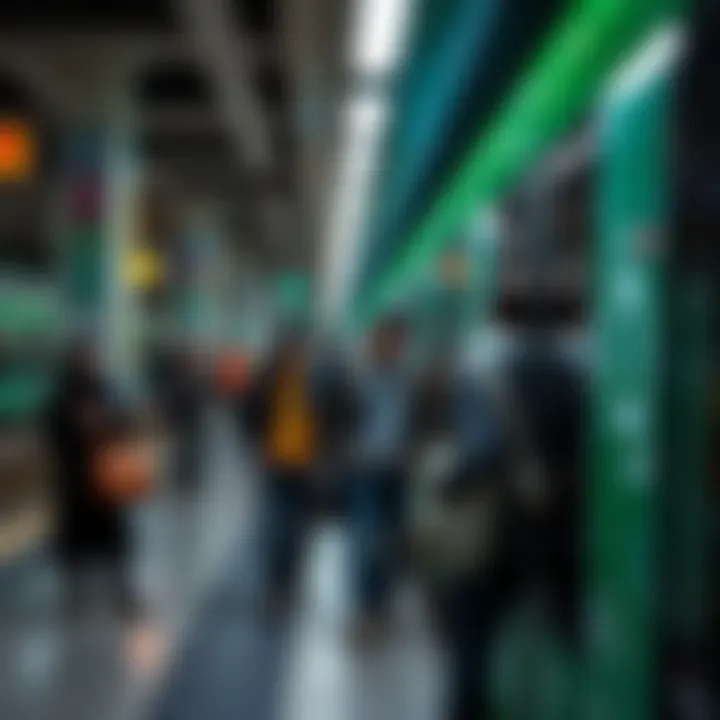
The commercial landscape alongside the Green Line is similarly thriving. Business ventures are sprouting up like daisies, drawn by a steady flow of potential customers right at their doorstep. Retailers and service providers keen on targeting the bustling commuting populace find the Green Line an attractive proposition.
Key Commercial Prospects Include:
- Retail Spaces: Shopping centers and boutique shops along the Green Line cater to daily commuters as well as residents, establishing a symbiotic relationship with the metro's user base.
- Cafes and Restaurants: Food establishments are popping up, taking advantage of the foot traffic and creating vibrant dining scenes that allow for social engagement.
- Offices and Co-Working Spaces: There’s been a marked increase in demand for office spaces near metro stations. Businesses value the convenience for their employees, encouraging productivity through accessible transport links.
In summary, the Green Line not only shapes urban mobility but also influences lifestyle habits. The residential and commercial evolution along its route demonstrates a shift towards a more interconnected and vibrant city life. As Dubai continues to progress, the Green Line remains at the heart of transforming the metropolitan experience into one of convenience and community.
Challenges and Solutions
Understanding the challenges faced by the Green Line of the Dubai Metro is crucial for grasping its overall impact on the urban infrastructure. Throughout its operational history, various hurdles have prompted responses that not only address immediate concerns but also foster long-term improvements. Analyzing these challenges offers insight into how urban transportation systems can adapt and evolve, enhancing not just transit but also community frameworks.
Operational Challenges
The operational challenges of the Green Line are numerous and varied. One significant issue is the demand management—there's often a significant surge in ridership, especially during peak hours. This creates bottlenecks at popular stations like Union and Al Rigga, resulting in overcrowding and delayed services. Additionally, maintenance of rolling stock and track infrastructure demands constant attention. To tackle this, the Dubai Roads and Transport Authority (RTA) has implemented a strategic maintenance schedule. This includes upgrading signals and performing regular inspections while ensuring minimal disruption to service.
Another concern is the integration of new technologies into the existing framework. While the Green Line is celebrated for its efficient and advanced operations, incorporating smart transit solutions represents a constant challenge. Keeping technology updated while training staff to utilize it effectively is vital. Training programs are essential, ensuring that personnel are familiar with innovative systems that enhance service delivery.
Community Engagement
Community engagement plays a pivotal role in the success of the Green Line. For vital public infrastructure like this metro line, achieving buy-in from residents is key. The RTA has held several outreach programs and workshops aimed at educating the public about the benefits of the metro. These initiatives not only address concerns about noise and operations but also collect valuable feedback for future upgrades.
Moreover, community feedback aids the RTA in anticipating and resolving issues before they escalate. This participatory approach builds trust between the agency and the public, encouraging more individuals to utilize the metro rather than relying on personal vehicles.
With growth in populations around the Green Line, efforts to enhance community amenities around stations are also in place. Initiatives such as parks, cycling tracks and retail spaces not only enhance the usability of the metro but also improve the overall quality of life in surrounding areas.
"Engagement with the community not only aids in smoothing operational challenges but also ensures the metro remains relevant and beneficial for all residents".
In wrapping up this section, the exploration of these challenges and solutions speaks volumes about how urban planning and operational strategies can interact to create a seamless experience for riders. As the Dubai Metro continues to evolve, ongoing attention to these issues will be pivotal in shaping the future of public transport in the city.
Relevant resources for further reading include:
Future Prospects
As Dubai continues to expand, the Green Line of the Dubai Metro is set to play a crucial role in shaping the future of urban mobility and development. Understanding the future prospects of this vital transit line is paramount not only for city planners and policymakers but also for investors, homebuyers, and property managers looking to leverage the metro's growth. The ongoing developments and initiatives associated with the Green Line indicate its significant potential in enhancing urban connectivity and transforming the real estate market.
Planned Extensions
The Green Line, which connects the bustling commercial and residential neighborhoods of Dubai, has plans for future extensions that aim to broaden its reach and increase its effectiveness. These extensions are not just about laying down new tracks; they involve strategic planning to include more stations that serve densely populated areas and upcoming developments.
For instance, one notable proposal is to extend the line towards Dubai South, an area that is becoming increasingly important, particularly with the development of the Dubai Expo site and the Al Maktoum International Airport. Some key considerations for these extensions include:
- Increased Accessibility: More stations mean that more residents and visitors will have direct access to the metro, reducing reliance on personal vehicles and contributing to lower traffic congestion.
- Economic Boost: By connecting key areas, these extensions will likely foster economic growth, attracting businesses and enhancing property values in surrounding neighborhoods.
- Integration with Other Transport Modes: Future expansions will focus on seamless connectivity with other forms of public transport, such as buses and the planned hyperloop tracks, ensuring comprehensive coverage of the urban environment.
Integration with Smart City Initiatives
The integration of the Green Line with Dubai's smart city initiatives stands to redefine urban living and commuting. The city is on the journey towards becoming a model of sustainability and technological innovation, and the Green Line is at the forefront of this transformation. With smart technology, the metro network can enhance user experience and operational efficiency.
Incorporating smart technologies involves:
- Real-Time Data Utilization: Using real-time data for passenger flow management can help optimize schedules and improve the overall commuter experience. This includes crowd management during peak hours and providing passengers with live updates on train arrivals.
- Energy Efficiency: The implementation of energy-saving technologies and renewable energy sources will minimize the ecological footprint of the metro system. This aligns with Dubai's mission to nurture environmentally friendly practices across its urban infrastructure.
- Mobile Ticketing and Smart Payment Solutions: Simplifying fare payments through mobile applications can enhance convenience for users while also minimizing operational costs.
"The synergy between the Green Line and Dubai’s smart city strategy will not only improve transport convenience but also encapsulate the essence of progress in urban mobility."
The End
As we draw the curtains on this exploration of the Green Line, it’s crucial to reflect on its pivotal role in Dubai's intricate transportation network. The Green Line stands as more than just a mode of transit; it embodies the pulse of a vibrant city, intertwining with lives, businesses, and dreams.
Summative Reflection on the Green Line's Role
The Green Line’s importance transcends the mere act of commuting. Here are several key elements to consider:
- Accessibility: Connecting districts and communities, the Green Line enhances mobility for both residents and visitors alike, making urban exploration much easier. The link between various neighborhoods fosters a sense of unity, bringing distant areas closer together.
- Economic Stimulus: The metro line acts as a catalyst for investment and development. Property values near its station hubs have shown remarkable growth. Investors often look to purchase real estate in these areas, anticipating increased foot traffic and demand for services.
- Sustainability and Modern Living: In light of environmental challenges, the Green Line champions a sustainable paradigm, encouraging reduced car dependency and promoting energy-efficient transportation. This modern approach aligns with Dubai's broader goals of sustainability, making it an attractive feature for eco-conscious residents.
- Cultural Impact: Stations along the Green Line serve as cultural nodes, contributing to the city’s identity. They are not just stops but gateways to experience local life, art, and cuisine, enriching the commuter experience.
- Future Potential: As more extensions are planned and smart city initiatives roll out, the Green Line will likely continue evolving. This openness to innovation ensures that it can adapt to the changing needs, maintaining its relevance in the fabric of Dubai.
"To travel is to live. The Green Line exemplifies a journey, one that connects dreams with destinations."
Investors, homebuyers, and property managers should keep a keen eye on the transitions happening along this line—after all, it reflects the essence and future of Dubai.















